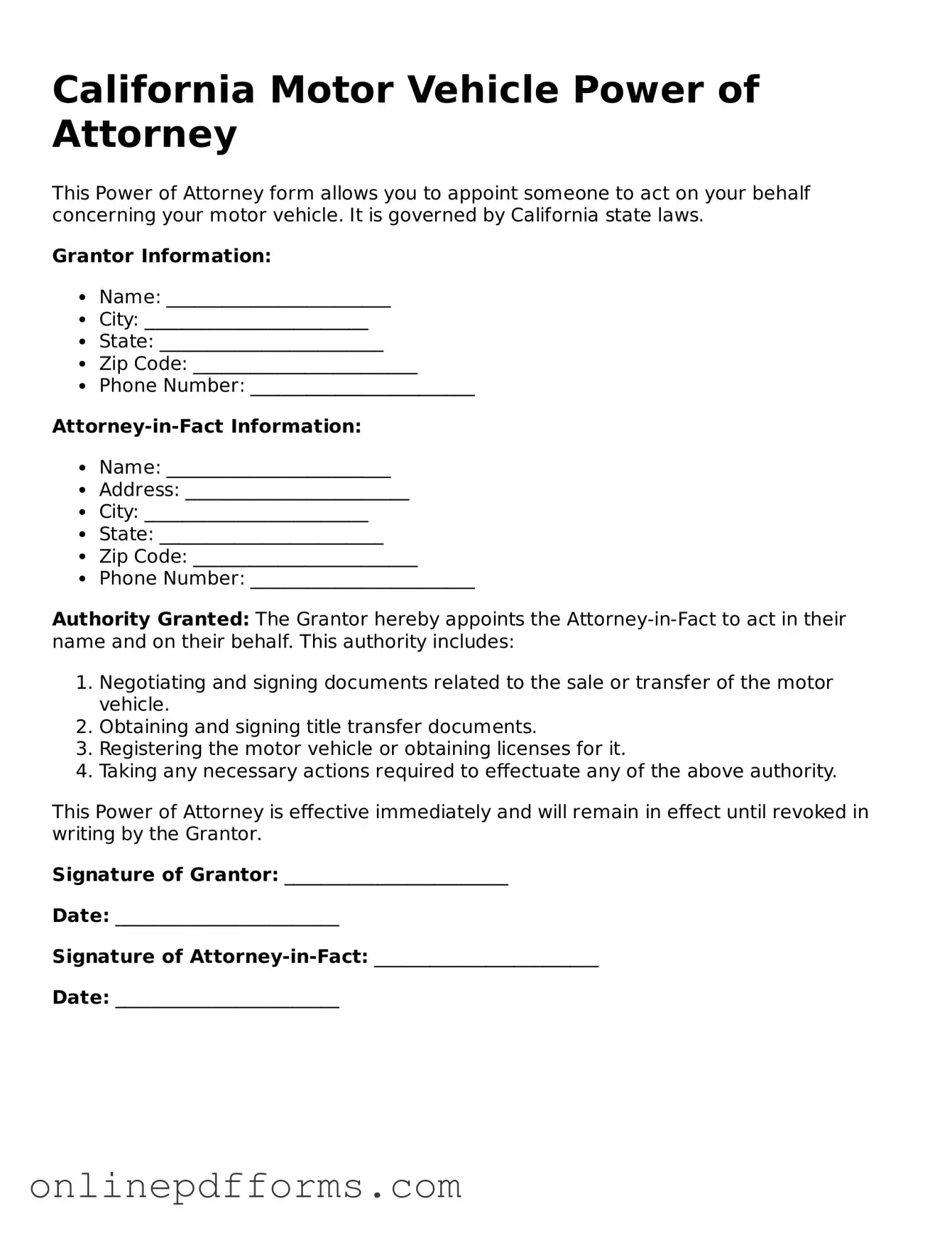The California Motor Vehicle Power of Attorney form is similar to a general Power of Attorney (POA) document. Both forms grant authority to an agent to act on behalf of another person. In the case of a general POA, the scope of authority can be broad, covering financial and legal matters. The motor vehicle version, however, is specifically tailored to vehicle-related transactions, such as registering a car or transferring ownership. This specificity makes the motor vehicle POA a useful tool for individuals who need to delegate vehicle-related tasks without relinquishing control over other personal matters.
Another document that shares similarities is the Durable Power of Attorney. This form remains effective even if the principal becomes incapacitated. Like the motor vehicle POA, it allows the agent to make decisions on behalf of the principal. However, the Durable Power of Attorney can encompass a wide range of decisions beyond vehicle matters, such as healthcare and financial decisions. The motor vehicle POA is limited to vehicle transactions, making it a more focused alternative for those specific needs.
The Limited Power of Attorney is also comparable. This document allows the principal to specify the exact powers granted to the agent, which may include vehicle-related actions. The motor vehicle POA is a type of limited POA, as it restricts the agent's authority to matters concerning motor vehicles. This tailored approach ensures that the principal maintains control over other aspects of their life while enabling the agent to handle necessary vehicle transactions.
A Vehicle Title Transfer form is another relevant document. While not a power of attorney, it is often used in conjunction with the motor vehicle POA. The title transfer form is essential for officially changing the ownership of a vehicle. The motor vehicle POA can authorize an agent to complete this form on behalf of the principal, streamlining the process of transferring vehicle ownership without requiring the principal's direct involvement.
The Bill of Sale is similar in that it is used during the sale of a vehicle. This document serves as proof of the transaction between the buyer and seller. The motor vehicle POA allows an agent to sign a Bill of Sale on behalf of the principal, facilitating the sale process. While the Bill of Sale itself does not grant authority, it works in tandem with the motor vehicle POA to ensure that all legal requirements are met during the transaction.
The Application for Title or Registration is another document that aligns with the motor vehicle POA. This form is required when registering a vehicle with the state. The motor vehicle POA can empower an agent to complete and submit this application on behalf of the principal. This delegation is particularly useful for individuals who may be unable to handle the registration process due to time constraints or other obligations.
The Bill of Sale is an essential document in the realm of vehicle transactions, as it not only confirms the sale but also protects both the buyer and the seller by providing a clear and enforceable record of the agreement. When dealing with RVs specifically, utilizing the correct documentation is crucial for ensuring a smooth transfer of ownership, and for those in Wisconsin, the Auto Bill of Sale Forms can be an invaluable resource.
Lastly, the Vehicle Release form can be considered similar. This document is used to release a vehicle from a lien or other legal claim. The motor vehicle POA can authorize an agent to sign this release, allowing for the removal of any encumbrances on the vehicle. This is crucial for individuals looking to sell or transfer ownership of a vehicle that has been previously encumbered.
